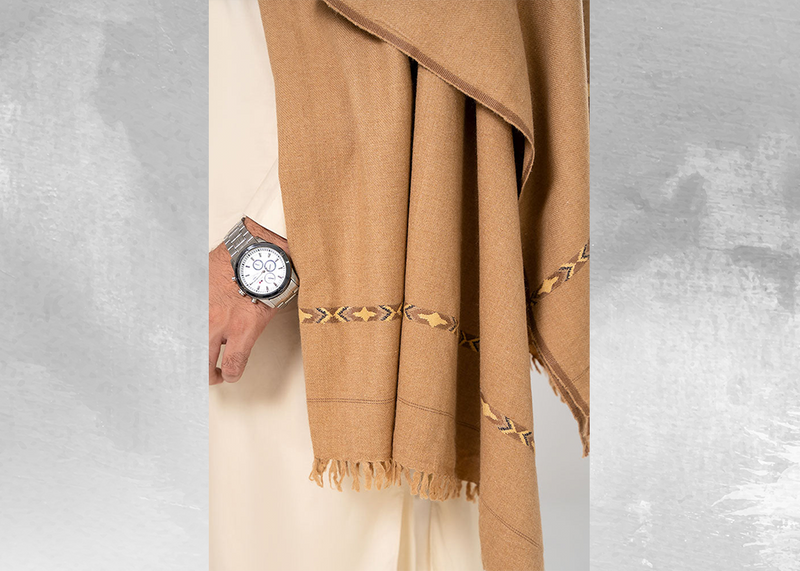When selecting the best shawl, pay close attention to the quality and feel of it, as these will be the deciding factors on whether you’ll be able to wear it comfortably all day long. The micron and thread count are two critical factors which dictate the softness, warmth, and longevity of a shawl. At Sarwat, we make every shawl with the highest quality to provide you with maximum comfort, style, and luxurious feel. What are microns and thread count, and how do they affect your shawl? That being said, let me explain further and see how these would affect your premium shawl's experience.
What is Micron in Shawls?
Microns refer to the thickness of the fiber used in making the fabric. A micron is a unit of measurement equal to one-millionth of a meter. The finer the fiber, the lower the micron count, and the softer and smoother the shawl becomes. Microns play a significant role in determining the softness, warmth, and luxurious feel of the fabric.
For instance, 60/60 refers to a specific micron count used in shawl making. This indicates a fine, soft fabric that is comfortable to wear and feels luxurious against the skin.
Fine vs Coarse Fibers
-
Fine Fibers: The lower the micron count, the finer the fiber. Fine fibers, like 60/60, are softer and lighter, making the shawl feel comfortable and delicate.
-
Coarse Fibers: Higher micron counts (e.g., 100/1) indicate thicker fibers, which may result in a coarser, heavier fabric. These shawls provide warmth but might not feel as smooth or breathable as those made with finer fibers.
What is Thread Count?
Thread count refers to the number of threads woven into a square inch of fabric. Higher thread counts usually indicate a denser fabric, contributing to better durability and a smoother finish. In the context of shawls, thread count plays a crucial role in the smoothness and comfort of the material.
Thread Count Examples: 96/2, 70/30, and 100/1
-
96/2: This indicates the number of threads per inch. A thread count of 96/2 means that the fabric is woven with 96 threads per square inch and the yarn is twisted into two-ply (two threads twisted together). This creates a balanced texture, providing strength without compromising softness.
-
70/30: The first number represents the number of threads, while the second number represents the ply. A 70/30 ratio means that 70 threads are used per square inch, with 30% of them being two-ply. This creates a fabric that is slightly thicker and more durable, with a subtle texture.
-
100/1: This refers to the finest quality of thread count, with 100/1 representing a high-end, premium shawl. It’s woven from threads that are both dense and fine, giving the shawl a luxurious feel with a smooth texture.
How Microns and Thread Count Affect Feel and Durability
-
Comfort: The finer the microns and the higher the thread count, the more comfortable the shawl will feel against your skin. For example, 60/60 fibers combined with a high thread count, like 96/2, offer a soft, breathable, and luxurious texture, making them perfect for all-day wear.
-
Warmth: A finer fiber with a higher thread count helps to trap warmth more effectively. If you’re looking for a shawl that will keep you warm during colder months, opting for 100/1 or 70/30 fabric might be a better choice. These thicker fabrics tend to provide more insulation while still maintaining a smooth feel.
-
Durability: Shawls made with higher thread counts, like 96/2, are generally more durable. The finer, tighter weave ensures that the fabric resists wear and tear, which means it will last longer and retain its softness even after multiple uses and washes.
Conclusion:
When selecting a shawl, it’s important to understand how microns and thread count affect the overall quality, comfort, and feel. Shawls with a 60/60 micron count and a 96/2 thread count offer a balance of softness, durability, and luxury. However, if you’re looking for extra warmth and a thicker fabric, options like 100/1 or 70/30 could be ideal.
By understanding these factors, you can choose a shawl that not only looks elegant but also provides the desired level of comfort, warmth, and longevity for your needs. Whether it’s for a special occasion or everyday wear, the right shawl will elevate your style and provide unmatched comfort
